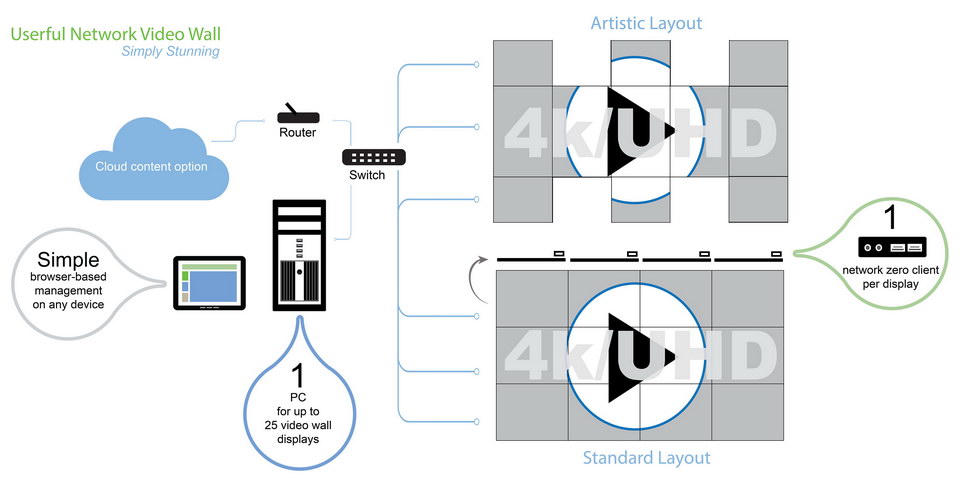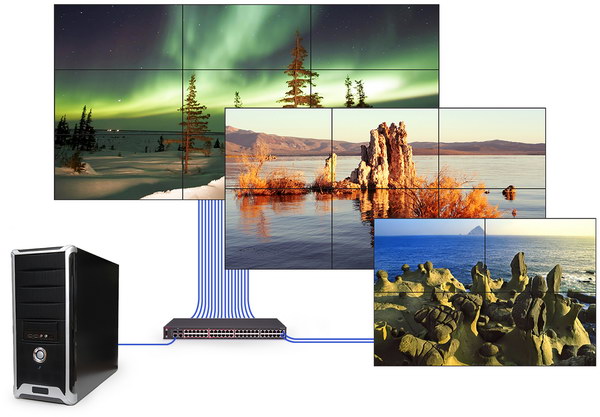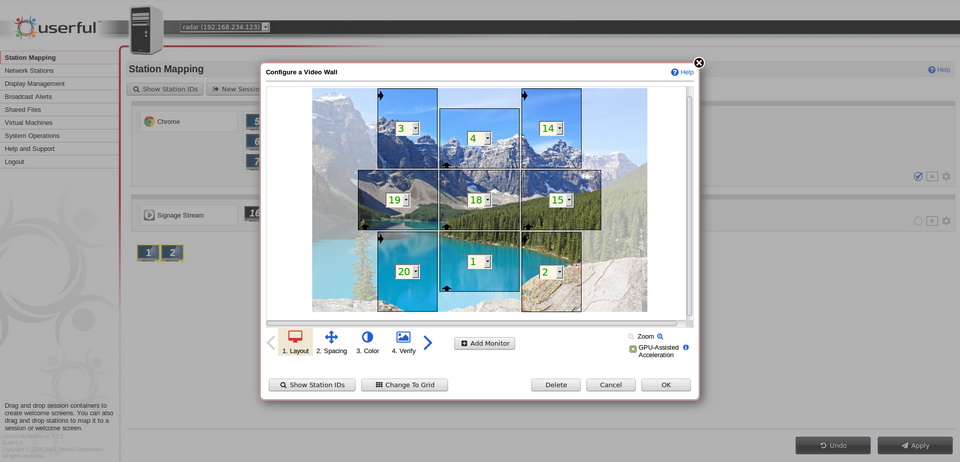Controllers/Scalers/Processors – Userful Corporation (Calgary Alberta) announced today the availability of its software solution to the videowall problem, which had initially been announced in October.
The solution leverages the company’s background in desktop virtualization (VDI) software suited for small/medium businesses with minimal IT support. Userful, a privately held company founded in 2003, is the provider of VDI software for over 1 million virtual computers in over 100 countries and works with zero, ultra thin and thin client devices from partners including HP, Acer, ViewSonic, Centerm, ThinGlobal and Atrust.
I had a chance to talk to Daniel Griffin, VP Multiplied Computing at Userful, about its videowall solution, which can handle real time video at resolutions up to 4k. He said the system will support HTML-5 content at up to 6k resolution and still images at a whopping 32k. In addition to normal 2D content, Userful software can be used for 3D content as well.

The Userful system supports both rectangular tiles and artistic layouts. Video goes to each display in the array via gigabit Ethernet.
Griffin added that the video resolution limit is not in the Userful software but the Intel Haswell Core i7 processor, where the associated GPU can only handle 4k video. He said for video up to 4k, a non-IT person can set the system up “out of the box”. While it is possible to set up the system for higher video resolution, Griffin said, by using the i7 cores to do some of the GPU processing, this is probably not something an end user could do without extra help from Userful. When Intel introduces a processor that will handle more than 4k video, end-users can upgrade their systems by replacing the host computer with no need to upgrade the videowall array.
The Userful videowall system uses a single Intel Haswell Core i7 PC to process the video and divide it up in a number of uncompressed video streams delivered to the individual displays in the videowall. A single host computer can have up to 25 displays attached to it. These displays can be arranged in a single array or in several different arrays. While the maximum video resolution is 4k, Griffin said a single host can handle up to two 4k streams and direct them toward different video wall arrays.

One Userful host can handle multiple display arrays, as long as the total display count is under 25.
At each display in a Userful array there is a network client with Ethernet and USB input and video output connected to the display. According to Griffin, these clients typically cost less than $200 and contain no main memory, hard drive, etc. Their main function is to take in the uncompressed video to be displayed on the attached display and scale it to the pixel count of the attached display. The client can also pass along control signals from the host system, for example to turn the display on and off or dim it for night-time use.
The Userful videowall system is a display control solution, not a content management solution (CMS). Griffin says Userful has partnered with Rise Vision, a supplier of CMS software, to provide content management. He says Userful works with other CMS systems as well. For example, I recently wrote an article on the Barco X2O CMS. Since the X2O system produces HTML-5 output, it should interface to the Userful system with no problem.

Screen shot of the Userful software during the videowall setup process.
I asked Griffin about arrays of edge-blended projectors. He said the Userful software will not do the edge blending itself. If the projectors have built-in edge blending, as many high-end projectors do, you can use the Userful “Bezel” function with a negative number to create the overlapping images needed by edge-blending projectors.
When I first heard of the Userful software-based videowall controller system, I immediately assumed it was similar to the Hiperwall software-based videowall controller system I had written about earlier. Other than being software-based and using Ethernet to connect the host to the displays, they have little in common and have completely different software architectures. In addition, the Hiperwall solution has content management inseparably intertwined with display management. Hiperwall also cannot handle 4k/UHD video, although the company is promising that capability “soon.”
For a user who is satisfied with his CMS software (or doesn’t want to make the effort to change) but wants a low-cost, software-based videowall controller, Userful would be a better choice than Hiperwall, where you need to use its CMS. Anyone interested in learning more about the Userful solution can attend the company’s webinar, “New Userful Network Videowall”, scheduled for December 10.
There are a lot of alternatives to Userful, Hiperware, X20 and the many other hardware and software videowall solutions I wrote about after InfoComm earlier this year. For example, Networld Media Group recently issued its 2014 report on CMS for digital signage and compares 171 different packages targeting that market. I’m glad I don’t have to chose between all the alternatives. – Matthew Brennesholtz

